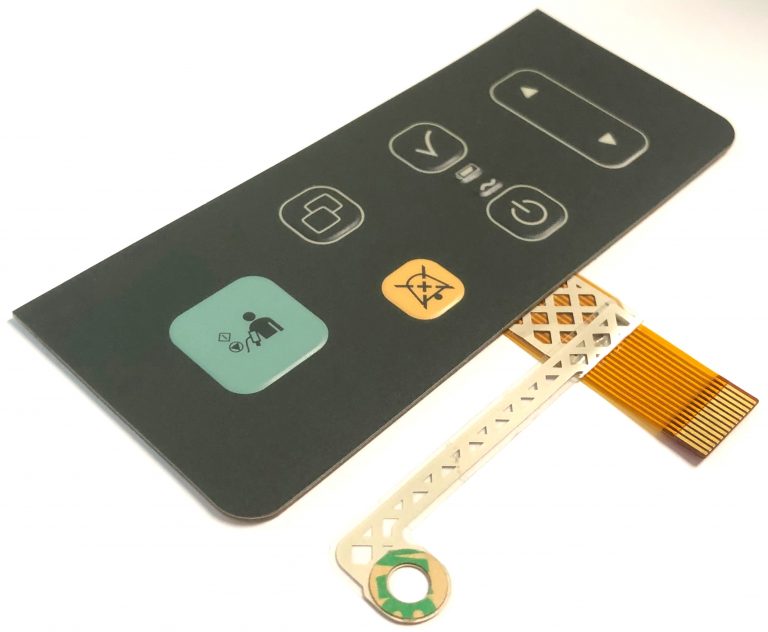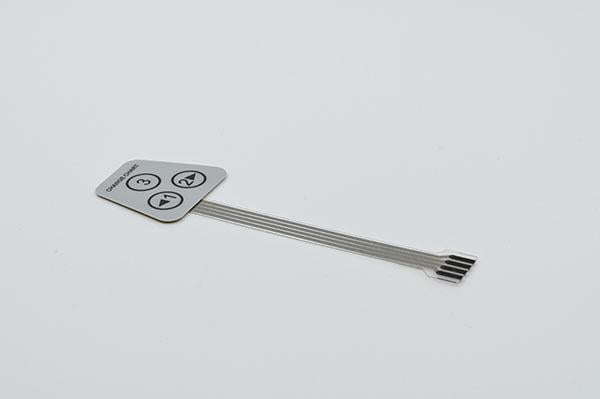If durability matters, sourcing from a reliable membrane switch manufacturer is crucial.
Everything About Membrane Switch: Recognizing Its Layout and Capability
When you believe regarding the control user interfaces in modern tools, membrane layer buttons usually come to mind. Let's explore what sets membrane layer switches apart from various other control systems.
What Are Membrane Switches?

Membrane layer buttons can also be customized relating to form, dimension, and graphics, permitting suppliers to produce unique user interfaces tailored to particular products. In general, membrane layer switches play a considerable role in boosting user experience across a vast array of applications.
How Membrane Changes Job
When you push a trick on a membrane button, it turns on a straightforward yet efficient device. The top layer, typically made from adaptable material, pushes down onto a conductive layer underneath it. This action bridges the void between conductive traces, completing an electric circuit. As quickly as the circuit shuts, it sends out a signal to the gadget's controller, which interprets your input.
You'll discover that the responsive responses differs based on the switch style, offering either a soft click or a much more obvious reaction. Once you release the trick, the membrane go back to its original setting, resuming the circuit and quiting the signal. This procedure occurs practically immediately, making sure a responsive customer experience.
Membrane switches are preferred due to their longevity and resistance to dust and wetness, making them ideal for numerous applications, from family home appliances to medical tools. Comprehending this procedure assists you appreciate their extensive usage.
Secret Components of Membrane Switches
Comprehending the key elements of membrane layer switches is fundamental for understanding their functionality and layout. The safety layer guards against ecological variables and put on, expanding the switch's life-span. By comprehending these components, you'll gain understanding right into exactly how membrane layer changes run and their value in various applications.
Products Made Use Of in Membrane Switch Layout
The efficiency and toughness of membrane switches greatly rely on the products used in their layout. You usually come across polyester and polycarbonate as main substrates due to their outstanding toughness and flexibility. These materials stand up to scratches and chemicals, making them suitable for demanding atmospheres.
The conductive layers usually utilize silver or carbon, picked for their reliability and conductivity. membrane switch manufacturer. Silver offers superior efficiency, while carbon is an affordable option. For the overlay, you could consider a matte or shiny coating, depending on your visual needs and user experience
Adhesives play an essential function too; they bond layers firmly and assure longevity. Make sure to choose adhesives that stand up to ecological factors like temperature and moisture. Do not overlook the value of an excellent printing method for graphics, as it improves both performance and aesthetic allure. Choosing the right materials will guarantee your membrane switch stands the test of time.
Design Considerations for Membrane Buttons
While developing membrane layer switches, it's vital to take right into account different elements that affect their performance and user experience. Beginning by concentrating on the layout and button dimension; make particular they're intuitive and simple to browse.
Do not neglect the graphic style; clear labeling and shade contrast are considerable for visibility. Verify your style fits ecological aspects, like dampness or temperature level variations, which might impact efficiency. Remember the value of screening models with real customers click for more to gather feedback and make required modifications. This repetitive process assists you refine the style, validating it meets both practical and aesthetic requirements effectively. By thoroughly considering these aspects, you'll develop a membrane layer button that boosts use and complete satisfaction.
Applications of Membrane Layer Switches
Membrane switches are flexible parts found in numerous applications, from industrial tools to consumer electronics. You'll see their effect in devices that call for durable interfaces and in devices that benefit from find sleek layouts. Comprehending these applications helps you appreciate the performance and practicality of membrane layer switches in daily technology.
Industrial Devices Use
When you're looking to improve the capability of commercial tools, membrane switches use a reputable option that incorporates toughness with straightforward design. These switches are perfect for rough settings, providing resistance to dirt, dampness, and chemicals. Accept membrane buttons to simplify your operations and enhance overall performance.
Customer Electronic Devices Assimilation
In the domain of customer electronics, membrane layer switches play a necessary role in boosting individual communication and tool performance. You'll discover them in tools like microwaves, push-button controls, and pc gaming consoles, offering a smooth means to connect with modern technology. Their smooth layout enables for simple combination into numerous products, making controls user-friendly and straightforward. With their ability to include graphics and backlighting, you can enjoy a contemporary aesthetic that matches the device's general appearance. Membrane switches additionally ensure resilience and resistance to dust and moisture, extending the life-span of your electronics. By selecting membrane buttons, you improve not simply the performance however also the design of your devices, making daily communications smooth and pleasurable.
Benefits and Drawbacks of Membrane Buttons
While membrane layer switches use a variety of benefits, they additionally come with some disadvantages that you should take into consideration. One considerable advantage is their compact layout, making them ideal for space-constrained applications. They're likewise cost-effective, supplying a durable service with a reduced manufacturing cost. Furthermore, their smooth surface area is very easy to clean, improving health in settings like health centers.

Nevertheless, there are drawbacks. Membrane layer buttons can have a shorter life internet expectancy compared to mechanical switches, particularly under hefty use. They can likewise be less tactile, which might affect user comments during operation. If damaged, repairing them can be tough and commonly needs total replacement. Ultimately, their sensitivity to severe temperatures and ecological problems may limit their effectiveness in certain setups. Stabilizing these advantages and disadvantages will certainly aid you establish if membrane layer switches are the ideal fit for your project.
Often Asked Inquiries
For How Long Do Membrane Layer Changes Usually Last?
Membrane layer changes usually last in between 5 to 10 years, depending upon usage and ecological conditions. You'll desire to evaluate variables like wear, direct exposure to dampness, and temperature changes to gauge their durability properly.
Can Membrane Layer Switches Over Be Personalized for Particular Layouts?
Yes, you can customize membrane switches to fit specific styles (membrane switch manufacturer). You'll have the liberty to pick shades, shapes, and designs that match your task's requirements, guaranteeing they mix perfectly with your overall visual
What Is the Price Array for Membrane Layer Change Manufacturing?
The price range for membrane switch manufacturing normally falls in between $1 and $10 per device, depending on aspects like layout complexity, amount, and materials. You can obtain quotes from producers to discover the most effective option.

Are Membrane Changes Water-proof or Immune?
Membrane layer buttons can be created to be waterproof or resistant, depending on materials utilized and building techniques. If you need them for damp atmospheres, assure you define those needs throughout the design process.
How Do Membrane Layer Switches Over Contrast to Conventional Buttons?
Membrane layer switches are typically thinner and a lot more adaptable than traditional buttons, offering a sleek design. They're usually much easier to cleanse and incorporate, yet could not offer the responsive feedback you're utilized to with mechanical alternatives.
Conclusion
